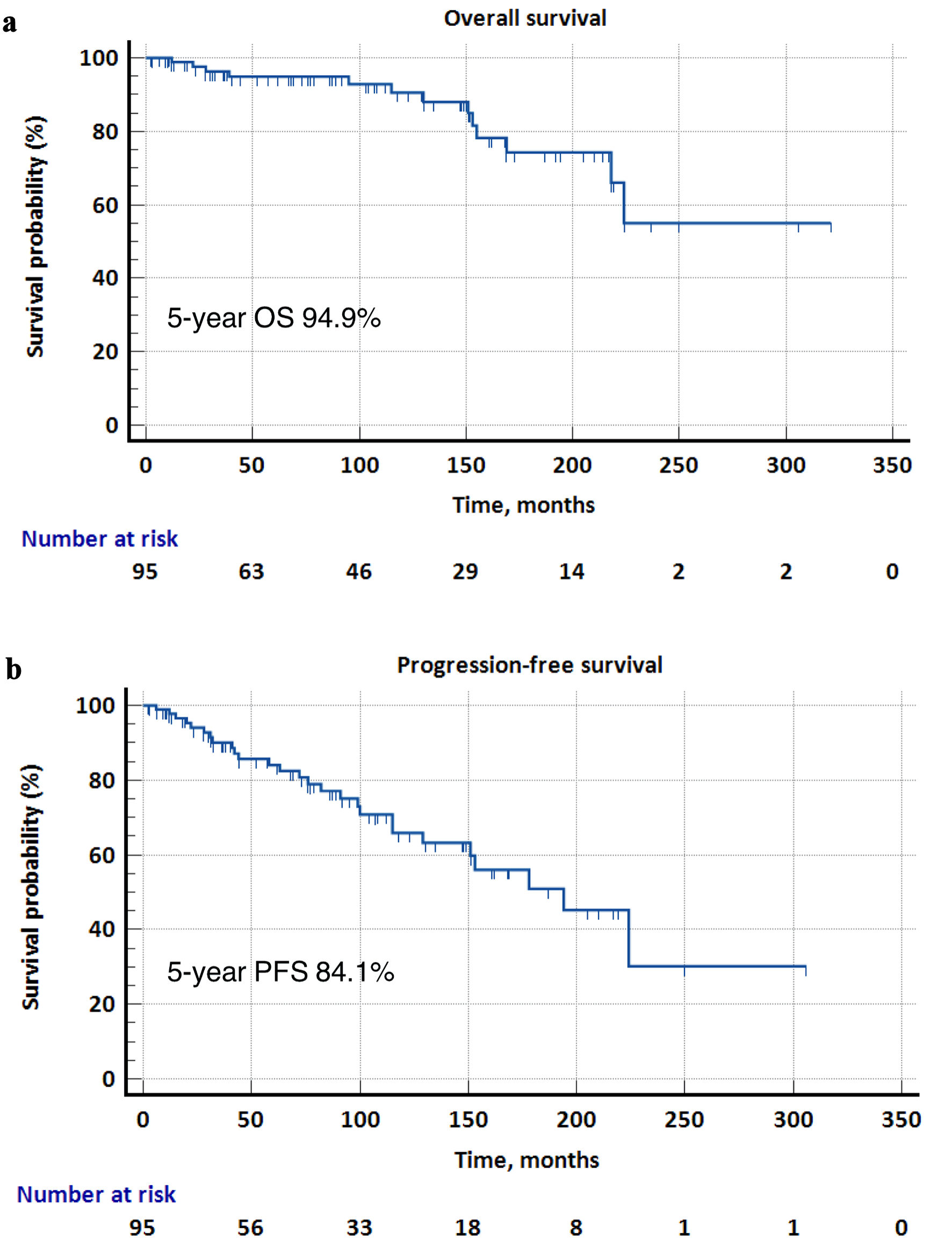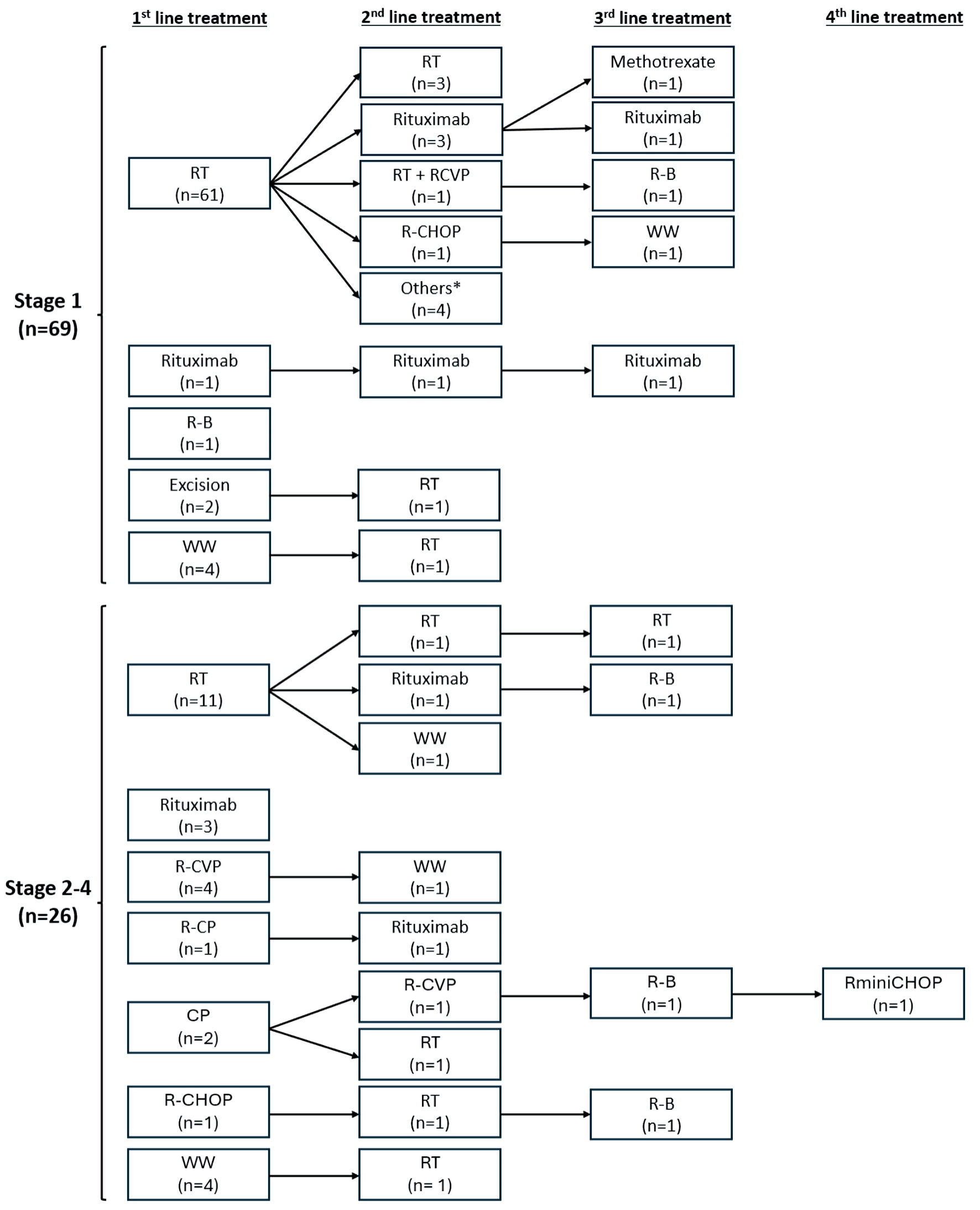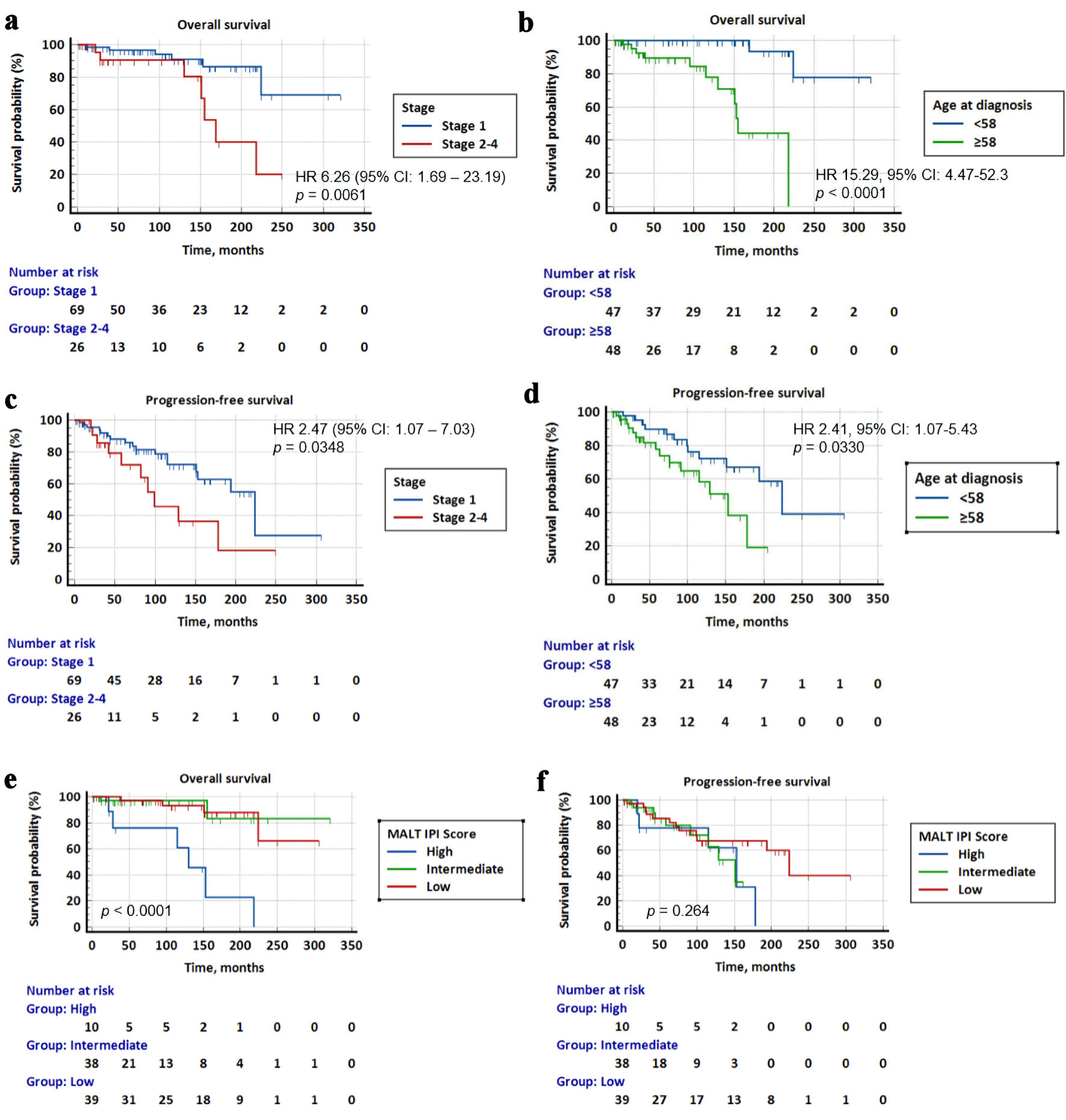Figures

Figure 1. Kaplan-Meier survival curves for overall survival (OS) and progression-free survival (PFS) in the overall cohort. (a) The 5-year OS was 94.9%, and the median OS was not reached. (b) The 5-year PFS was 84.1%, and the median PFS was 194 months.

Figure 2. First- and subsequent-line treatment therapies stratified by disease stage. Others: R-B (n = 2), bendamustine alone (n = 1), CVP (n = 1). CP: chlorambucil, prednisone; R-CP: rituximab, chlorambucil, prednisone; CVP: cyclophosphamide, vincristine, prednisone; R-CVP: rituximab, cyclophosphamide, vincristine, prednisone; R-CHOP: rituximab, cyclophosphamide, doxorubicin, vincristine, prednisone; RminiCHOP: rituximab plus reduced dose CHOP; R-B: rituximab, bendamustine; RT: radiation therapy; WW: watchful waiting.

Figure 3. Kaplan-Meier survival curves for overall survival (OS) and progression-free survival (PFS) stratified by Ann Arbor stage, age at diagnosis and MALT-IPI score. (a) Patients with stage 2-4 disease had significantly poorer survival than patients with stage 1 disease (HR = 6.26, 95% CI: 1.69 - 23.19, P = 0.0061). (b) Patients above 58 years had significantly lower survival than younger patients (HR = 15.29, 95% CI: 4.47 - 52.3, P < 0.0001). (c) Patients with stage 2-4 disease had a significantly poorer PFS than patients with stage 1 disease (HR = 2.47, 95% CI: 1.07 - 7.03, P = 0.0348). (d) Patients above 58 years had a significantly lower PFS than younger patients (HR = 2.41, 95% CI: 1.07 - 5.43, P = 0.0330). (e) OS for low vs. intermediate vs. high MALT-IPI score. Patients with high MALT-IPI score had significantly worse OS than patients with low and intermediate IPI scores (HR = 9.28, 95% CI: 1.24 - 69.11, P < 0.0001, and HR = 10.99, 95% CI: 1.34 - 89.94, P < 0.0001) respectively. (f) PFS for low vs. intermediate vs. high MALT-IPI score. There was no significant difference in PFS of patients with different MALT-IPI scores. MALT-IPI: mucosa-associated lymphoid tissue International Prognostic Index; HR: hazard ratio; CI: confidence interval.

Figure 4. Representative 18-FDG PET/CT images of ocular marginal zone lymphoma based on anatomical location, and SUVmax values at diagnosis stratified by Ann Arbor stage and tumor site. (a) Bilateral enlarged and FDG-avid lacrimal glands (left, SUVmax 3.1; right, SUVmax 8.8). (b) Bilateral FDG-avid lower eyelid masses (left, SUVmax 7.8; right, SUVmax 4.0). (c) FDG-avid mass over medial-superior aspect of the left globe (SUVmax 5.5). (d) FDG-avid nodular lesion on the left orbit (SUVmax 4.4). Red arrows indicate the site of disease. (e) Patients with stage 2-4 disease had significantly higher SUVmax values compared to patients with stage 1 disease (P = 0.035, Mann-Whitney U test). (f) There was no significant difference between SUVmax values across different tumor sites, though eyelid tumors had numerically higher uptake values (P = 0.18, Kruskal-Wallis test). SUVmax: maximum standardized uptake value.
Tables
Table 1. Demographic and Clinical Characteristics of Patients With OAMZL
| Characteristics | N (%) |
|---|
| MALT-IPI: mucosa-associated lymphoid tissue International Prognostic Index; SD: standard deviation; LDH: lactate dehydrogenase; IgG: immunoglobulin G. |
| Total patients | 95 (100) |
| Sex | |
| Male | 60 (63.2) |
| Female | 35 (36.8) |
| Age at presentation | |
| Median (range) | 58 (25 - 88) |
| Mean ± SD | 56.2 ± 14.0 |
| Laterality | |
| Right | 38 (40.0) |
| Left | 38 (40.0) |
| Bilateral | 19 (20.0) |
| Ethnicity | |
| Chinese | 76 (80.0) |
| Malay | 10 (10.5) |
| Others | 9 (9.5) |
| Stage at presentation | |
| I | 69 (72.6) |
| II | 8 (8.4) |
| III | 2 (2.1) |
| IV | 16 (16.8) |
| Location in ocular adnexal region | |
| Orbit | 47 (49.5) |
| Conjunctiva | 15 (15.8) |
| Lacrimal gland | 22 (23.2) |
| Eyelid | 11 (11.6) |
| Symptoms | |
| Swelling | 31 (32.6) |
| Mass/lump | 20 (21.1) |
| Proptosis | 18 (18.9) |
| Erythema | 8 (8.4) |
| Ptosis | 8 (8.4) |
| Diplopia | 5 (5.3) |
| Decreased visual acuity | 5 (5.3) |
| Restricted eye movement | 5 (5.3) |
| Pain/discomfort | 4 (4.2) |
| Watery eyes/tearing | 3 (3.2) |
| Not reported | 31 (32.6) |
| Serum LDH status | |
| Elevated | 27 (28.4) |
| Not elevated | 60 (63.2) |
| Unknown | 8 (8.4) |
| MALT IPI score | |
| Low (0) | 39 (41.1) |
| Intermediate (1) | 38 (40.0) |
| High (2 - 3) | 10 (10.5) |
| Unknown | 8 (8.4) |
| Known autoimmune disease | |
| IgG4 disease | 9 (9.5) |
| Sjogren’s syndrome | 2 (2.1) |
| Unspecified connective tissue disease | 1 (1.1) |
| Site of initial disease spread | |
| Lymph nodes | |
| Above diaphragm | 14 (14.7) |
| Below diaphragm | 6 (6.3) |
| Unspecified | 2 (2.1) |
| Extranodal sites | |
| Lung | 3 (3.2) |
| Paravertebral | 3 (3.2) |
| Renal pelvis | 3 (3.2) |
| Stomach | 3 (3.2) |
| Bone marrow | 1 (1.1) |
| Breast | 1 (1.1) |
| Pleura | 1 (1.1) |
| Pericardium | 1 (1.1) |
| Pelvic side wall | 1 (1.1) |
Table 2. First-Line Management of Patients With Ocular Lymphoma in the Study Cohort
| Stage | Management strategy | N (%) |
|---|
| aOther chemotherapy: CP (chlorambucil, prednisone) (n = 2), R-CP (rituximab, chlorambucil, prednisone) (n = 1), R-CHOP (rituximab, cyclophosphamide, doxorubicin, vincristine, prednisone) (n = 1). R-CVP: rituximab, cyclophosphamide, vincristine, prednisone. |
| 1 (n = 69) | Radiation therapy alone | 61 (64.2) |
| Rituximab alone | 1 (1.1) |
| Rituximab + bendamustine | 1 (1.1) |
| Excision alone | 2 (2.1) |
| Watchful waiting | 4 (4.2) |
| 2-4 (n = 26) | Radiation therapy alone | 11 (11.6) |
| Rituximab alone | 3 (3.2) |
| R-CVP | 4 (4.2) |
| Other chemotherapya | 4 (4.2) |
| Watchful waiting | 4 (4.2) |



